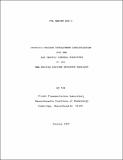Computer program development specification for the air traffic control subsystem of the Man-Vehicle Systems Research Facility.
Author(s)
Unknown author
DownloadFTL_R_1982_01.pdf (4.342Mb)
Other Contributors
Massachusetts Institute of Technology. Flight Transportation Laboratory
Metadata
Show full item recordAbstract
Functional summary: The Air Traffic Control (ATC) Subsystem of the Man-Vehicle System Research Facility (MVSRF) is a hardware/software complex which provides the MVSRF with the capability of simulating the multi-aircraft, multi-controller Air Traffic Control environment required to perform full-mission flight simulations. The ATCSIM CPCI is the software component of this complex. The ATCSIM operates in three modes: 1) Standalone, that is, without the required participation of the rest of the MVSRF. 2) Single-cab mode, with either the conventional (727) or advanced cab. 3) Dual-cab mode, with both simulated cabs. The ATCSIM is capable of simulating up to three simultaneous ATC radar positions and up to 40 aircraft (called "pseudo-aircraft" to differentiate them from the cab aircraft(s)). The ATC subsystem performs the following functions: 1) Simulates the movements of up to 40 pseudo-aircraft. 2) Simulates the navigational and surveillance equipment in the area. 3) When in the single or dual cab mode, it communicates with the host computer and the cab computer(s) to receive data concerning the cab positions as well as directives regarding the management and control of the ATC environment. 4) Drives up to three simulated ATC positions, each equipped with a calligraphic display scope and a keyboard. The human operator of each ATC position (called the air traffic controller) can monitor the aircraft movements on the calligraphic display and can control them through clearances communicated to the pseudo-pilots (see next item) via audio channels provided for this purpose. The keyboard can be used to enter aircraft clearances and to modify the information displayed on the radar screen. 5) Drives up to three pseudo-pilot positions, each equipped with a video terminal and a keyboard. The operator of each pseudo-pilot position (called the pseudo-pilot) will at any point be responsible for "piloting" up to 12 aircraft. He is responsible for responding to clearances received from the air traffic controller regarding any aircraft under his control. To accomplish this task, the pseudo-pilot will have complete status information on all the aircraft under his control displayed on the video screen at all times. To initiate the execution of the clearance received by the air traffic controller, a repertoire of piloting commands will be available to him. Those will have to be entered on the keyboard along with appropriate identification of the target aircraft.
Description
January 1982
Date issued
1982Publisher
Cambridge, Mass. : Massachusetts Institute of Technology, Flight Transportation Laboratory, [1982]
Other identifiers
13201665
Series/Report no.
FTL report (Massachusetts Institute of Technology. Flight Transportation Laboratory) ; R82-1
Keywords
Air traffic control, Computer programs